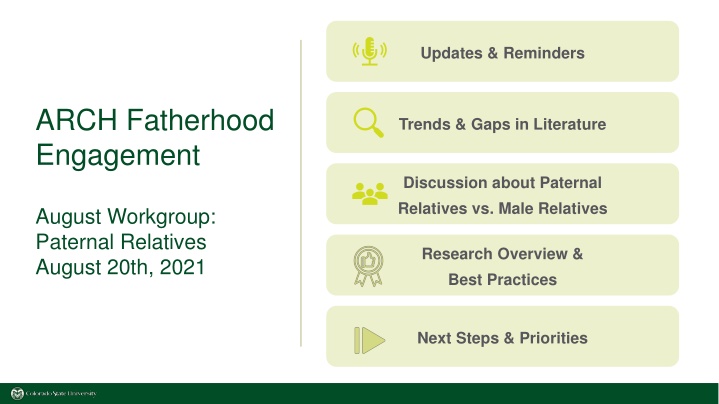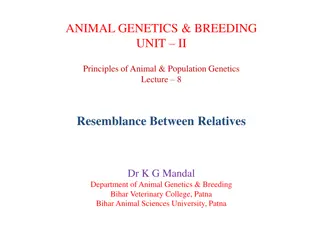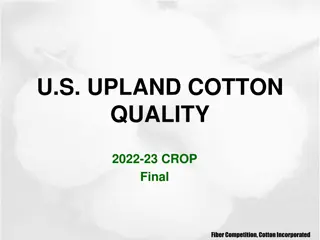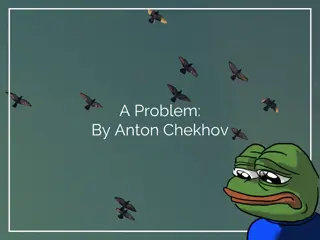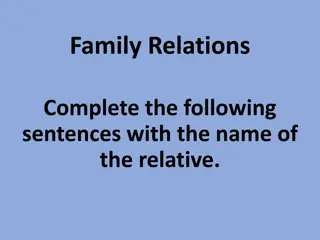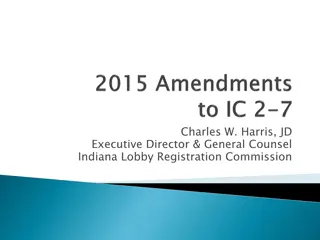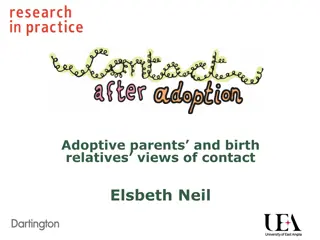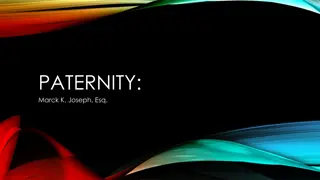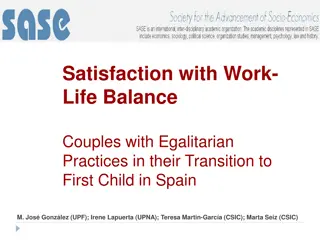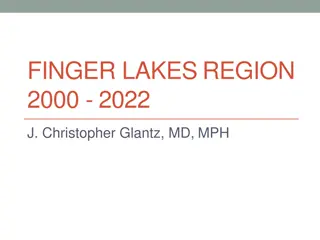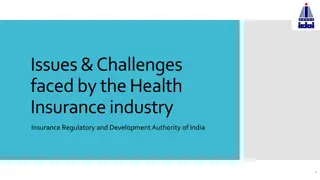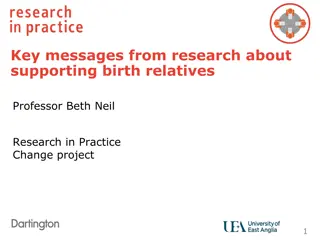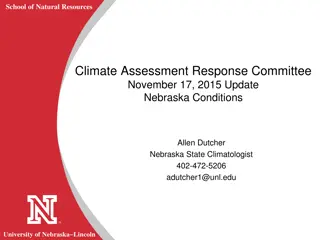Trends in Engaging Paternal Relatives: Insights and Best Practices
Literature on engaging paternal relatives in child welfare is limited, with existing research focusing on comparisons between paternal and maternal placements, male and female caregivers, and outcomes based on sociodemographic factors. Key takeaways include complexities in engaging non-resident fathers, challenges in rapport building, maternal preference for foster care, and limitations in notification laws for paternal relatives.
Uploaded on Sep 19, 2024 | 1 Views
Download Presentation

Please find below an Image/Link to download the presentation.
The content on the website is provided AS IS for your information and personal use only. It may not be sold, licensed, or shared on other websites without obtaining consent from the author.If you encounter any issues during the download, it is possible that the publisher has removed the file from their server.
You are allowed to download the files provided on this website for personal or commercial use, subject to the condition that they are used lawfully. All files are the property of their respective owners.
The content on the website is provided AS IS for your information and personal use only. It may not be sold, licensed, or shared on other websites without obtaining consent from the author.
E N D
Presentation Transcript
Updates & Reminders ARCH Fatherhood Engagement Trends & Gaps in Literature Discussion about Paternal Relatives vs. Male Relatives August Workgroup: Paternal Relatives August 20th, 2021 Research Overview & Best Practices Next Steps & Priorities
Updates & Reminders Past, Present, and Future 1 2 3 Previous months: Caseworkers Perspectives & Fathers Perspectives Next Meeting: Paternal Relatives, Part 2 This meeting: Paternal Relatives
Updates & Reminders Request from El Paso: new fatherhood mentoring program; any other counties willing to talk about their experiences navigating background screens for similar programs? Infographic in development All About Dads infographic ready for distribution Be Bold for the Needs of Dads is ready for review
Identifying and Engaging Paternal Relatives in Child Welfare: What We Know
Paternal Relatives: Topics for Today Trends in Literature Updates from the Workgroup Research Summary: Demographic Findings Outcomes Findings Best Practices 3
Trends in Literature There is not much research specifically on the engagement of paternal relatives; those that do exist primarily focus on: Comparing paternal vs. maternal placements Comparing male vs. female caregivers Engaging fathers and paternal relatives There could be a potentially compounding effect of male, paternal caregivers, but this is rarely explored Male caregivers tend to be more socially isolated, but not more dissatisfied with their caregiver experiences than female caregivers Significant differences in child welfare outcomes were more consistently attributed to sociodemographic factors other than caregiver sex, specifically: Single caregiver versus with a partner (poorer outcomes for single caregivers) People caring for multiple children (poorer outcomes for more children) Socioeconomic status may impact caregiver satisfaction (less satisfaction for lower socioeconomic status) Some literature comparing maternal vs. paternal kinship care outcomes share investigation outcomes not whether those investigations were founded or not
KEY TAKEAWAYS FROM THE LAST WORKGROUP 1 2 3 4 5 6 Implication of using the language of non-resident fathers and non- custodial parent Paternal relative engagement can complicate rapport between caseworker, mom, and maternal relatives Maternal preference for foster care over paternal relative care Limitations with notification laws for maternal vs paternal relatives Perception of father and paternal relatives based on relationship between mother and father Bias against paternal relatives seen in court system, too
If child welfare officials operate from a vantage point that men are willing, capable, and ready to assume the caregiving role, the search for resources and viable placement options for children will be expanded. - pg. 7, Denby et al., 2014
Typical profile of a kinship caretaker is an elderly, female relative who is typically connected to the child through the maternal bloodline1 Male caregivers have begun to emerge more recently, but services still disproportionately cater to women1 Trends & Patterns of Kinship Care Kinship caregivers are more likely to be of the child(ren) s maternal line than their paternal line1 Men who assume responsibility or express a desire for the responsibility of kinship care are often met with reservations from caseworkers about their readiness to provide adequate caretaking and they may be less likely to ask for help2.7 Reduced funding for child welfare agencies has played a role in the rise of kinship care, but kin families often receive less financial and other support than traditional stranger foster families, despite having lower incomes, less education, more health challenges, and more dependents in the home on average1
Evolutionary Psychology3,4 Evolutionary Psychology posits that children will be less likely to experience harm if they are in the care of a biological relative, and that the more genetic material that we share with someone, the more imperative we have to care for them Sex considerations: Without a DNA test, only the mother and her relatives can be certain that the child is theirs Evidence base seems to suggest that stepfathers who live with non-biological children are more likely to neglect or maltreat the children Societal Considerations and Relevant Social Theories Maternal Relatives Outside Child Welfare5 Even outside of the child welfare system, both men and women tend to turn to their maternal relatives when resources are scarce, when men are unreliable providers, when marital relationships are unstable, and when paternity may be in question this could be hard to combat in casework
SOCIODEMOGRAPHIC TRENDS Maternal relatives4,5 Paternal relatives4,5 More likely to be living under the poverty line Less likely to be living under the poverty line More likely to have a mental health problem More likely to be employed and have attained more education, and less likely to experience mental health challenges Higher rates of unemployment, less education, and severe health challenges Most likely to be grandfathers, but there are relatively high rates of older siblings, aunts, and uncles Largely grandmothers on the maternal line Some researchers interpret these demographic data to signify that maternal relatives may to be more motivated to step forward as caregivers under difficult circumstances
MATERNAL RELATIVES PATERNAL RELATIVES Higher average number of months to4 maltreatment investigation Lower average number of months to maltreatment investigation4 Children had more frequent and severe behavioral problems4 Children had better overall behavior with fewer and less severe behavioral problems4 PLACEMENT OUTCOMES Less than a quarter received subsidies4 Less than a quarter received subsidies4 17% of placements had a maltreatment investigation within 280 ~50% had a maltreatment investigation within 280 days4 days4 More likely to break down within a year (~2/3 of placements that ended within 1 year)5 Less likely to break down within a year (~1/3 of placements that ended within 1 year)5
SOCIODEMOGRAPHIC TRENDS Female caregivers Male caregivers Less likely to be married1 More likely to be married1 Less likely to be employed full-time or have education greater than high school1 More likely to be employed full-time and have education greater than high school1 Very likely to be grandmothers1 Likely to be uncles and brothers in addition to grandfathers1 Tend to have wider and more sustainable social Report higher levels of personal fulfillment, mutual engagement, and self-awareness8 networks10 Have been found to report poorer overall psychological health and greater stress9 Have been found to report better overall psychological health9 In a comparison of 70 male and 645 female caregivers, there was no significant difference in caregiver motivation and sustaining factors, caregiver readiness and capacity, family involvement and social support, or caregiver perceptions of child wellbeing. Studies report mixed findings on caregiver self- reported stress, psychological health and support networks
SUMMARY There is no consistent, strong consensus on the impact on child welfare outcomes or wellbeing outcomes of maternal vs. paternal placements or male vs. female caregivers. Evidence suggests that maternal placements tend to be more stable, but that children in maternal placements may have more behavior issues. Research also suggests that, while male caregivers may be less common and less supported by family or society, male caregivers report equally high levels of motivation and satisfaction from their caretaking roles
Promising Strategies for Engaging Fathers & Paternal Relatives (FPR) A promising strategy that hinges on the underlying goal of breaking down the maternal focus of the child welfare system by including fathers and paternal kin in decision-making. It strives to widen the circle of support for the child(ren) while empowering fathers and paternal relatives to make investment in their children s lives by including paternal relatives in case planning and case activities. In one study, an average of 3 paternal relatives attended each family conference Family Group Decision Making (FGDM)6,11,12,13 Fathers & Paternal Relatives as More than Placement Candidates13 One article discussed how child welfare agencies have a pattern of disengaging with nonresident fathers and paternal relatives if they determine that they are not candidates for the child(ren) s placements, even when they could still provide important support to the child(ren) Some scholars advocate for more frequent use of genograms, where caseworkers work with a father to chart the network of all of those who may be able to support them and their children specifically, paternal relatives Genograms13
Implementing Fostering Connections Act: How Does This Look at Your Agency? Required Notification practices Required notification practices to notify all known relatives both maternal and paternal within 30 days of a child s removal from a home Foster Care Standards Agencies may waive non-safety-related standards for relatives seeking foster home licensing for a related child Permanent Guardian vs. Adoption Adoption may not always be the best option; subsidized guardianship programs allow grandparents and other relatives to become permanent guardians outside of the foster care system and receive continued financial support Nonresident fathers can and should be involved in their child(ren) s transition planning out of foster care as a role model, support system, and/or source of information Transition Planning
Initial Identification of the FPR: Requests to identify, timing of identification Metrics and Measurements for Father & Paternal Relative Engagement: Promising Goals & Strategies from the BSC13 Leveraging Additional Resources in Identification: # of sources and attempts to use additional agencies or sources to locate FPR Placement Notification and Options: Documentation of notifying FPR of new placements; documentation of rationale for FPR not being viable options Family Meetings with FPR: Documentation of invitation of FPR to family team meetings, assessment of participation of FPR in meetings Inclusion of FPR in Case Plans: Required input from FPR in case planning, evaluation of how needs of FPR are met by services, documentation of receipt of services by FPR, and self-report by FPR of their perception of whether their needs were met Visitation with FPR: Documentation of visitation and contact with FPR Reunification: Reunification with FPR
Breakthrough Series Collaborative Framework13 Domains for improving father and paternal relative (FPR) engagement Change concepts Support community, system, and agency environments that value and respect all FPRs ( supportive environments ) Offer peer mentorship and support to FPRs Engage staff in regular conversations, education, and coaching about historical, institutional, cultural, and structural racism Cultivate racial equity for men of color in the child welfare system ( racial equity ) Identify and locate FPRs from the first point of contact with the family ( identification and location ) Collaborate with other agencies to locate FPRs Assess and address the strengths and needs of, and barriers for, FPRs ( assessment ) Explicitly include strengths, needs, and supports in the initial and ongoing assessment of FPRs Continuously involve FPRs throughout the lives of their children ( continuous involvement ) Engage FPRs in permanency planning meetings and decisions
Next Steps General reactions / questions / comments to today s slides How can we share these data most effectively? How about the best practices? Would a 1-page best practices document be helpful? How can we support the implementation of these best practices? Looking back on caseworker perspectives and fathers perspectives, would a one-pager similar to All About Dad be helpful for sharing? Thoughts on topics moving forward?
Email Us: Casey Blackwatters casey.blackwatters@colostate.edu Lauren Alessi lauren.alessi@colostate.edu Additional Thoughts, Questions, Ideas, or Concerns?
References 1. Denby, R. W., Brinson, J. A., Cross, C. L., & Bowmer, A. (2014). Male kinship caregivers: Do they differ from their female counterparts? Children and Youth Services Review, 46, 248 256. https://doi.org/10.1016/j.childyouth.2014.09.003 2. Bullock K. (2006). Grandfathers raising grandchildren:an exploration of african american kinship networks.Journal of health & social policy, 22(3-4), 181 197. https://doi.org/10.1300/j045v22n03_12 3 . Tes t a, M ark F. & S l ack, K ri s t en S ho o k, 2002. "The gift of kinship foster care, "Chi l dren and Yo ut h S ervi ces Revi ew, El s evi er, vo l . 24 ( 1- 2) , p ages 7 9- 108. 4. Helton, J. J., Boutwell, B. B., & DiBernardo, M. (2017). The relative safety of paternal, maternal, and traditional foster care placements. Child Abuse & Neglect, 70, 1 10. https://doi.org/10.1016/j.chiabu.2017.05.006 5. Perry, G., Daly, M., & Macfarlan, S. (2014). Maternal foster families provide more stable placements than paternal families. Children and Youth Services Review, 46, 155 159. https://doi.org/10.1016/j.childyouth.2014.08.016 6. Pennell, J., & Burford, G. (1994). Widening the circle: Family group decision making. Journal of Child and Youth Care, 9(1), 1-11. 7. Brown, L., Callahan, M., Strega, S., Walmsley, C., & Dominelli, L. (2009). Manufacturing ghost fathers: The paradox of father presence and absence in child welfare. Child & Family Social Work, 14(1), 25 34. https://doi.org/10.1111/j.1365-2206.2008.00578.x 8. Ekwall, A. K., & Hallberg, I. R. (2007). The association between caregiving satisfaction, difficulties and coping among older family caregivers. Journal of Clinical Nursing, 16(5), 832 844. https://doi.org/10.1111/j.1365-2702.2006.01382.x 9. Park (2009) 10. Keith, P.M., Hill, K., Goudy, W. J., & Powers, E. A. (1984). Confidants and well-being: A note on male friendship in old age. The Gerontologist, 24, 318 320. http://dx.doi.org/10. 1093/geront/24.3.318. Casey Family Services. Family finding as a permanency strategy. Retrieved on September 25, 2009, from http://www.caseyfamilyservices.org/userfiles/pdf/bib-2009- family-finding.pdf 11. Schmid, J. (2006). The business of engaging fathers (and other male relatives) in the FGC process. Protecting Children, 21(1),20-29. 12. Fung, N. Bellamy, J. Abendroth, E. Mittone, D. Bess, R. Stagner, M. (2021). A Seat at the Table: Piloting Continuous Learning to Engage Fathers and Parental Relatives in Child Welfare. Mathematica.
